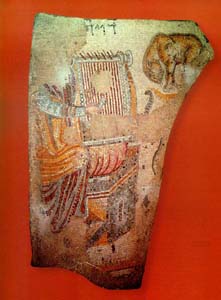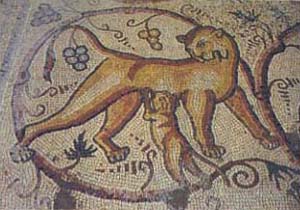sinagoga di wilayah Jalur Gaza
http://cojs.org/gaza_synagogue_mosaic-_6th_century_ce/
gambar-gambar mosaic sinagoga di Gaza

Raja Dawid dengan alat musik Lyre/Kecapi
King David with Lyre
The mosaic first became known to archaeologists in 1966, when the Italian journal Orientalia reported the discovery of an ancient church on the Gaza coast by the Egyptian Department of Antiquities. Within the church was a mosaic floor, described as depicting a figure of a female saint playing the harp and charming wild animals. Two pictures of the mosaic were included in the article.
When Hebrew University Professor Michael Avi-Yonah read this report, he immediately saw in the photos of the mosaic a Hebrew inscription that clearly read “David” (dywd). He correctly identified the figure as King David playing the harp and the building as a synagogue rather than a church.

anak singa menyusui
Suckling Lion
After the 1967 Six-Day War, when Israel took control of Gaza, Israeli archaeologists rushed to the site to inspect the synagogue and mosaic they had read about but had never seen.
The site had lain unprotected since its discovery in 1965. When the Israelis arrived, they found that part of the mosaic had been destroyed- David’s head, one of his hands and several other small areas were gone.
The Israel Department of Antiquities promptly sent a team headed by Professor Asher Ovadiah to excavate the site. The ancient synagogue turned out to be the largest ever discovered in the Holy Land.4 The exact plan is unknown; Ovadiah suggests that it was almost square (85 by nearly 100 feet) and probably consisted of a wide nave and two aisles on either side created by four rows of columns, two on either side of the nave.

singa betina melompat
Leaping Tigress
One entered the building through one of three entrances on the westernmost wall (at the bottom of the plan above). On the opposite wall was a niche, presumably for the Torah ark, and, in front of it, a podium (bema) from which the Torah scroll was read. This area was apparently divided from the rest of the prayer hall by chancel screens; lovely fragments of four intricately-carved marble chancel screens were found in the excavation.
The floor of the synagogue had been paved with beautiful mosaics. In the southernmost aisle, at right on the plan, was a well-preserved mosaic with the popular pattern of vines forming circles, or medallions, that contained animal figures. At the foot of this mosaic, flanked by two peacocks, is a Greek inscription by which the mosaic (and the synagogue) can be dated. It reads-
“(We) Menahem and Yeshua, sons of the late Isai (Jesse), wood traders, as a sign of respect for a most holy place, donated this mosaic in the month of Louos (the year of) 569.”
Connie Kestenbaum Green, “King David’s Head from Gaza Synagogue Restored,” BAR 20-02, Mar-Apr 1994.





